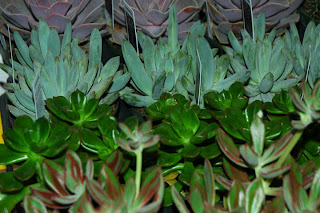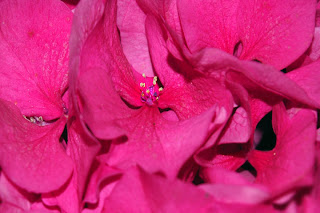I can clearly remember when I was a teenager a conversation between my mother and a friend of hers who was in the clothing trade, wherein the friend bluntly declared that denim was soon to run its course in terms of popularity. That was in 1975, and it seems that jeans just keep on going ,and denim may be more fashionable than ever. Clearly the humble fabric used to make tents during the Gold Rush (serge de Nimes and serge de Genes) is part of a long term trend.

In the floral trade the long term trend that shows no sign of abating is the continued strength of flowers that are green, and foliages that are variegated. In New York, Los Angeles and San Francisco the demand for green flowers started in earnest about twenty years ago, and over the last five years has spread into the heartland, as well as around the world. The most compelling argument for the trend to continue for many years to come is that green flowers continue to be strongly demanded in the Left and Right coasts' fashion centers. If the fashion for green flowers was coming to an end one would expect the cycle to be already in decline in the major cities.
For example, green roses, and especially Rosa "Supergreen", which is the premium product in the category, continue to be in very high demand. Yet this is merely at the apex of the flowers that are available in green, and many more cultivars are introduced each year: Rather ravishing are the green ranunculas that will be available this summer, as well as new varieties of chrysanthemums, carnations, zinnias. Stalwarts of the florists' varieties of green flowers such as hydrangeas and hanging amaranthus continue to enjoy very strong demand.
Another color trend that I have seen growing over the last few years is one that features palettes of desaturated colors. I suppose there may be a temptation to dismiss this as an ongoing variation on the pastel colors that have always been popular for weddings and romantic arrangements, but what I have observed is much more subtle than that and very hard to execute to high level of aesthetic satisfaction. And even the pastel colors themselves are used in very light hues and delicate tones. Colors can be described as sandy, beige, light tan, olive dun, lavender-gray, gray-pink, gray, antique ivory, Wedgwood blue, gray-blue, shell pink and flesh. Definitely not your mother-in-laws pastels!
Pantone presents their "color" of 20012 as "Honeysuckle Pink". The color as presented on their web site is certainly pink, a sort dusty pink with blue undertones. I often think these colors are selected as much for their name as for the actual color, like the swatches that the paint companies fabricate. Our native Honeysuckle Lonicera sempervirens is a fabulous blend of pinks, it is true, but also displays apricot, some golden hues and red. Notwithstanding Pantone's rather lacklustre selection, pinks in various hues do seem to be popular, and when the color is realized in fabulous flowers such as "Sarah Bernhardt" peonies, "O'Hara" roses, in Dahlias, Ranunculas and Hydrangeas to name a very few, the effect can be the epitome of romance.
One current trend that I find incredibly tasteless, but which seems to have legs at least through the end of this year is the insertion of "bling' and feathers into bridal bouquets. Shakespeare got it right when he proclaimed that to "gild the lily" was redundant, yet there seems to be a growing segment of society who insist on putting 'bling" into everything. One of the most disturbing things I have seen recently are large live beetles encrusted with gaudy bling to which a short chain is affixed. This chain is attached to the clothing above the chest and the living "brooch" wanders about your person. Pah-leez!! The parallel trend in flowers seems to have started with the very simple way stephanotis blooms were attached to a wedding bouquet with boutonniere pins, a technique that has been in use for several decades, but has now evolved into a garish and cheap metaphor for the deeply spiritual and romantic nuptial ceremony. Surely selling yourself does not mean mortgaging one's soul?
A tendency that is diametrically opposed to the bling-thing is that of composing arrangements and bouquets in a way that looks very relaxed and casual, as if thrown together in a vase. However, as anyone who has ever worked with flowers knows, this is an incredibly difficult thing to do and requires unerring skill that usually comes from many years of experience and an innate sense of aesthetic judgement. Many of the materials employed in this trend have an appearance of being gathered from a cutting garden, or collected on a country walk, featuring flowers of various colors, shapes and sizes as well as being of different scales. Fruits, berries and pods are often incorporated, as well as herbs and even vegetables. A knowledge of appropriate hydration and conditioning techniques are essential, and a mastery of the materials a prerequisite.
The actual arrangements need to be done quickly as unnecessary manipulation of the products can diminish their quality. In many ways this trend is much like modern cuisine found in many restaurants, that depends on superb, fresh ingredients, an understanding of the cooking methods, execution that embodies artistry and skill but all prepared with a minimum of fuss and manipulation.
One issue raised several times in the floral blogosphere last year; the question of an often restricted floral supply (usually of the items you proposed to a bride several months before) will continue. This is due in large part to the weak dollar that causes all imports to be more expensive, as well as a considerable number of farm closures in Colombia and Holland that continue to contribute to the diminished supply. While in percentage terms that contraction is fairly small, the fact that floral professionals worldwide are chasing many of the same products means that the shortages can become rapidly exacerbated and seem quite pronounced. This year I also believe that the cost of transportation will become an important component of the price, and a factor that will limit the scope and scale of imports by wholesalers. Clearly planning and good organisational skills will be more important than ever, and pre-ordering flowers, a modus operandi that was last actively practiced about 25 years ago will become a factor once again for serious floral professionals. It will be a good business strategy to forge strong relationships with your vendors and actively communicate with them as to supply forecasts, price structures and so forth.
There are murmurings that carnations will make a come back this year, but I am of the opinion that it will be a few more years until a real resurgence occurs. Certainly several high-end designers are using them now, but for very specific purposes, where they are are generally employed in paint-by-number situations on decorative balls from small to extremely large, as well as to cover walls and flat planes. I do rather like the way Bornay uses them to make petite field-scapes. However, I do not see them being used in arrangements or wedding bouquets for a year or two yet. One exciting development in the Dianthus caryophyllus world is the breeding of a new series of "Antique" carnations that will do much to finally lift the stigma of this ubiquitous flower.
Last but not least, fragrance in flowers, in every type of flower will continue to be an important driving force in the fashion of flowers, for many years to come.
PS - The image is of Cymbidium "Yellow River", which has nothing to do with what I wrote, but just goes to prove that there are no rules in floral design. Cymbidiums will continue to be hot, but you knew that!


































